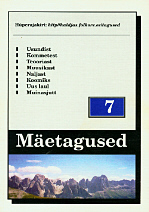Keerdküsimusest nii ja teisiti
About Conundrums This Way and the Other
Author(s): Piret Voolaid Subject(s): Customs / Folklore
Published by: Eesti Kirjandusmuuseum
Summary/Abstract: The current article is based on material from the file of conundrums of the Estonian Literature Museum's archive, containing approximately 20 000 texts and 1500 types. The material has been stored by the archive since the second half of the 19th century. Conondrums are quizzes of a relatively certain form (ie. a certain starting formula - an interrogative noun or expression). (For instance How do you understand there is an elephant in the fridge? There are slippers behind the fridge door.) The aim of asking these questions is to make the other a fool and pull his nose, as well as being entertaining. The neccessity to treat conundrums in a separate study has come forth in present day as the classical quizzes are less known, while its successros - conundrums, word games, puzzles, etc. - are becoming more popular. Currently the oldest known traditional conundrum originates from the third volume of Rosenplänter's "Beiträge" in 1814. The term conundrums originates probably in M. J. Eisen's 1914 book of puzzles "Mõista, mõista, mis see on ..." ("Guess, Guess What, This Is ...«), where the author names conundrums and word games under the name difficult questions. Throughout history, conundrums have been called with very different names: puzzles, short questions, funny questions, intersting questions, questions by the Armenian radio, joke questions, tricky questions, contemporary puzzles, legpulling questions. The three more important steps in treating conundrums are: 1. Mattias Johann Eisen discriminates them with a special term difficult questions (Eisen 1914, p 19); 2. Vaina Mälk (Mälk 1959, p 449) and Eduard Laugaste (Laugaste 1975, pp 291) discriminate them as a subtype of puzzles on the theoretical level; 3. Arvo Krikmann in his lecture material treats conundrums as a peripheral part of puzzles (Krikmann 1993, p 3). Currently, puzzles are treated as a separate genre with some certain characteristics ad teh subgenres of real puzzle, conundrum, etc. The problems are, that 1) the term puzzle has gained two meanings, where the general term has remained puzzle and puzzle in the classical sense is called now simple, classical or real puzzle; 2) conundrums, which used to be in the periphery, has reached the central with the developnt of folklore. (While in the Hurt collection, in the material from the end of the last century, there are only a few conundrums, then the 1992 schoollore competition resulted in only a few classical puzzles. Thus the problem: are conundrums a subtype of puzzles or something entirely different? Contemporary Estonian folklore treats conundrums as a subtype of puzzles. Probably it is not impossible that it will soon be treated as a separate genre.
Journal: Mäetagused. Hüperajakiri
- Issue Year: 1998
- Issue No: 07
- Page Range: 70-97
- Page Count: 28
- Language: Estonian

